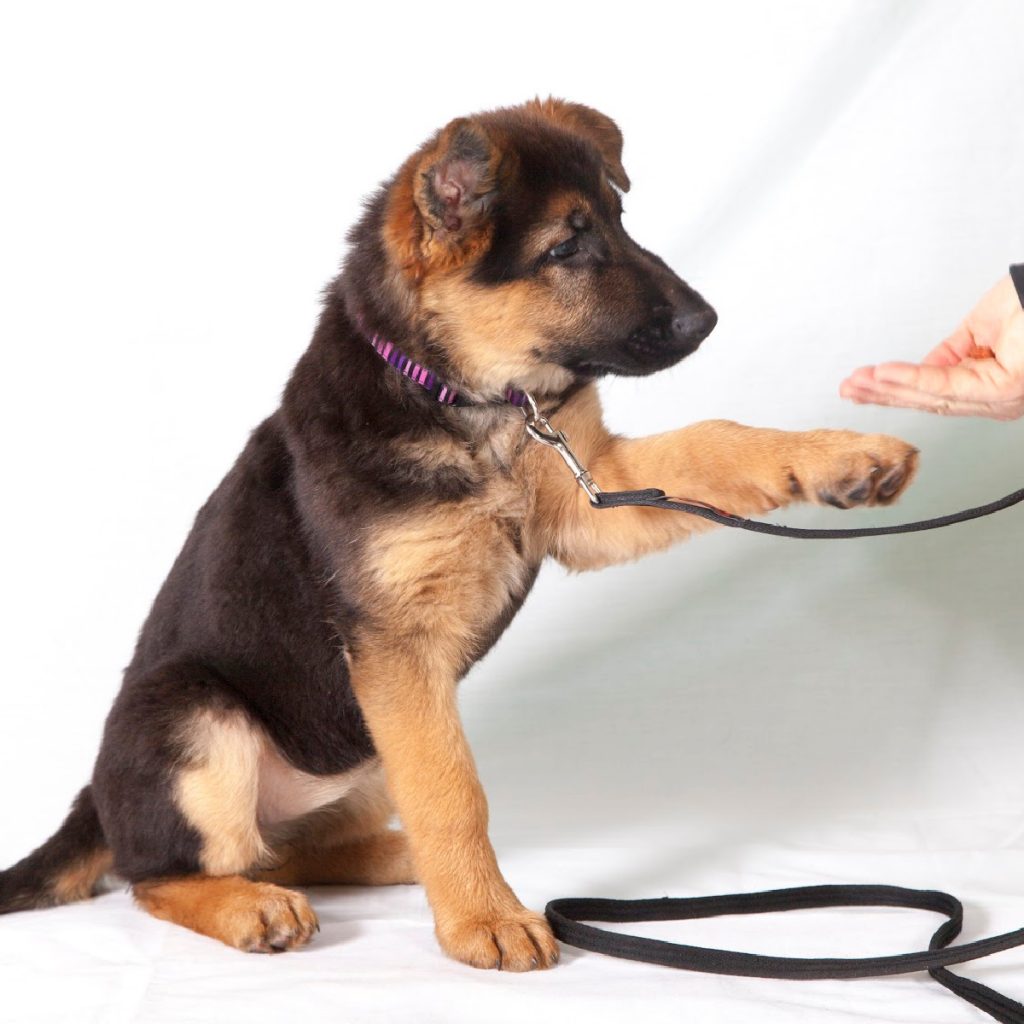Do you have trouble leash training your German Shepherd puppy and are in desperate need of some puppy training tips and tricks?
While German Shepherds are highly trainable, it’s not always easy to train an energetic puppy.
Fortunately, we’re here to help you with this 8 step guide on how to teach your German Shepherd to walk on a leash.

Guide to Leash Training a German Shepherd Puppy
Many people have the wrong expectations about leash training.
They think that puppies know how to walk on a leash instinctively and are surprised when the little one refuses to move, chews on the lead, or panics.
The earlier you start leash training your German Shepherd, the better the outcome.
German Shepherds quickly grow into powerful dogs that can drag you around with ease or pull the leash out of your hands.
So, let’s see the easiest way to leash train your German Shepherd puppy.
FYI, this post contains affiliate links. If you purchase through these links, we earn a small commission at no extra charge to you.
#1 Pick the Right Leash
Your first step in leash training your German Shepherd puppy is to find the right leash and collar.
Get the wrong one, and it will be easy for your puppy to drag you around or get hurt when pulling the lead.
What you need is a durable nylon or leather leash, short but not too short.
Four feet should do the job and allow you to control your puppy’s movement and prevent roaming.
Once your puppy gets used to walking, you can switch to a six-feet lead.
You also need a good collar for your German Shepherd puppy.
It shouldn’t be too tight to restrict your dog’s breathing, and it should sit comfortably high on the neck.
If you’re training an aggressive German Shepherd puppy, you might be considering shock or pinch collars.
Such collars are the worst way to train a dog because they stress your pet and might lead to aggression.
Instead, get a martingale collar or a no-pull harness.
- 【 Award Winning Brand】- America's Best Petcare Brands 2022 & 2021 Award by Newsweek Magazine and Statista.
- 【 SIZE 】Neck 14.5"-20", Width 3/4", Size Medium; All pictures are taken with our production samples in a size of Medium. Martingale collar is a slip collar designed for sighthounds but popular with other breeds. It does not have a buckle and does not stretch, so take measurements at the head and neck. Choose a collar size large enough to slip over the head
- 【 FEATUERS 】Martingale collars offer greater control without the choking effect of a slip collar, making them ideal for preventing escape. When fitted properly, they are comfortably loose when the dog is not pulling against the leash
- 【 CAUTION 】Martingale collars are not to be used as tie-outs and dogs should never be left unattended while wearing them. This product is not intended for use without a leash and is not suitable for indoor use. Matching leash (B073W915ZP) /harness (B073W9TN1D) /seatbelt (B073W8LQ8S) are available separately
- 【 MATERIAL 】The collar is made of durable polyester fabric and high-density webbing. Wipe to clean
#2 Make Preparations
Besides a leash, you’re going to need a couple of training tools to leash train your German Shepherd puppy.
Don’t worry. It’s nothing hard to get or expensive.
The most crucial training aid you need is training treats.
They should be high-value ones, which you’re going to use only for leash training your German Shepherd puppy.
If you use these tasty rewards often, they lose their meaning.
Moreover, you need a sound to mark good behavior. Its goal is to make your puppy connect the action with the tasty reward.
Some owners use “Yes!”; others rely on a clicker to mark the desired behavior. You can also click your tongue or use a dog training app.
#3 Introduce the Leash

Once you’ve picked a leash and a collar, it’s time to introduce your German Shepherd puppy to the collar and lead.
You want your puppy to have a positive experience with the leash before you take them outside:
- Put the collar/harness first. Let your puppy wear it while inside the house for short periods.
- Engage in some indoor games to distract the puppy from obsessing over the collar.
- Once your German Shepherd puppy is comfortable with the collar, attach the leash, and allow your puppy to roam the house. Make sure that your puppy doesn’t get tangled in something.
- Occasionally, pick the leash and call your German Shepherd puppy to come to you. If they do, reward them with a treat.
Don’t panic if the puppy starts chewing on the leash or attempts to remove it. That’s normal behavior.
Distract your German Shepherd puppy with a toy or a treat until they get used to the lead.
#4 Take Baby Steps
Go to a distraction-free area of the house with the puppy on a leash.
Allow your puppy to move around, and then make your sound cue – say “Yes,” use a clicker, or whatever command you’ve chosen.
When your German Shepherd puppy looks at you, give them a treat.
Continue to practice this routine for a few days. Soon you’ll notice that your puppy will come towards you when they hear the cue.
As soon as your German Shepherd puppy starts moving in your direction, take a few steps back.
Your pooch will follow anticipating the rewards, and when they do, you keep feeding treats.
That’s the foundation of leash training your German Shepherd puppy.
#5 Practice Walking Inside
Once your puppy comes to you when they hear your verbal cue, it’s time to move to the next level.
You’re going to practice walking. Yay!
Just as before, go to a place with few distractions and have the puppy on the leash.
Take a few steps, use your cue to attract your puppy’s attention, and keep giving your pooch treats as long as they stay by your side.
Since puppies don’t have a big attention span and tire quickly, plan short sessions throughout the day and end things while your puppy is still having fun.
It’s going to take your German Shepherd puppy a few days/weeks until they get the idea.
Don’t rush things, or you’re going to ruin your progress. And remember to use only positive reinforcement.
#6 Be Consistent
During the practice walks, you might notice that your puppy walks between your legs or moves from your left side to right.
That’s something you don’t want because the puppy can trip you or get hurt if they change directions suddenly.
To avoid incidents, pick a side before you start leashing training your German Shepherd puppy.
Reward your puppy with treats only when they’re staying close to you and walking on the correct side.
Most owners prefer their dogs to walk on the left, but you might be more comfortable with your dog on the right.
Whatever you decide, make it final because switching sides is going to confuse your puppy.
#7 Go For Short Walks

Once your German Shepherd puppy walks by your side and seems comfortable with the routine, you can go for your first real walk outside.
The secret is to keep it short until your puppy gets used to being outside.
A young puppy can become overwhelmed by new sights, sounds, and smells and get so excited that they forget all their training.
Keep lots of tasty treats at hand to attract your puppy’s attention and reward them when they behave.
In addition to this, don’t take your eyes off the puppy. You don’t want them to eat something from the ground or go after a cat or a bike.
As your puppy gets older and better at walking on a leash, you can move to teach your German Shepherd to walk on a loose leash and or try a hands-free lead.
#8 Tackle Problems
Lunging and leash pulling are the most common problems owners face when leash training their German Shepherd puppy.
You’ve got to know how to handle these situations, or you might make a mistake that will ruin your leash training progress.
Usually, when a dog pulls on the leash, the owner pulls back or allows the dog to drag them. Both strategies are wrong.
You stand your ground or walk in the opposite direction to teach your dog that there’s no point in pulling.
As for lunging, try distracting your puppy before they act.
If that doesn’t work, move away from your German Shepherd’s target and attract your dog’s attention with treats.
These strategies also work for excessive barking.
German Shepherds might be a highly trainable breed, but they are dominant dogs and can be stubborn.
Be strict, but not harsh when you’re leash training your German Shepherd puppy and make it a positive experience.
Then it’s a matter of time and practice.




